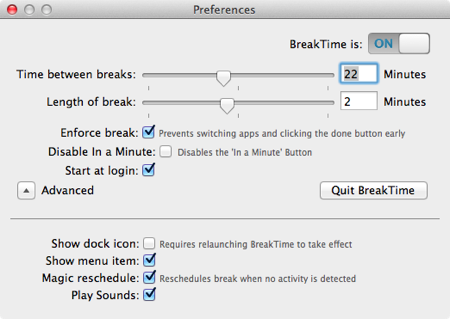I bought Breaktime.app (€3.99 on the MAS) 4 days ago and I am a happy customer. It is a very simple app, but definitely worth trying since it helps solving several of my problems.
After my ‘2012 resolution’ post, I’ve been trying new ways to push myself to do things and especially to spend more useful time on the computer.
This is when I found Breaktime. Its purpose is to force you to have breaks while on your computer. It will remind you to have a break away from the computer, or at least move your eyes away from the screen.
I’ve set up Breaktime to stop me every 20 minutes for 2 minutes each time. Why 20 minutes? It’s a mix between the Pomodoro technique, which recommends 25-minute work periods interrupted by short breaks to solve procrastination, and what experts recommend for your health and eyes.
On top of that, I’ve set up Breaktime to start at login and I highly recommend it. The point is not to worry about it, just let it do its thing. I also want the app to prevent me from switching to other apps and from hitting ‘done’ early. I do not want ways to cheat easily. I keep the ‘In a Minute’ button though for emergency cases.

So why do I recommend it? What is it useful for? It solves many of my problems:
Every 20 minutes, it will prompt me to stop staring at the screen. Something that I tried to force myself to do, but too hard without Breaktime. I therefore feel more comfortable working on my laptop.
Every 20 minutes, I will have 2 minutes to move and stretch. It will relax my back and neck and again make me feel more comfortable.
It will improve my productivity by giving me the feeling that I have a limited time ahead. I will feel a kind of urge and stop messing around.
Finally, I unexpectedly found myself going to bed quicker the past few days. When its starts to be late and suddenly the break comes up. It's easy to lay in bed waiting for the 2-minute countdown and never stand up again. This is the push you need.
In general, I feel less sucked by the computer, which is awesome.
It is simple to use, lightweight, well-designed and it solves problems. That’s money well spent.
